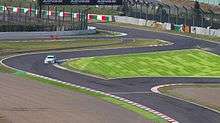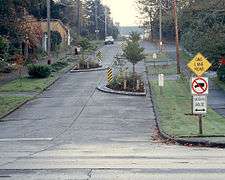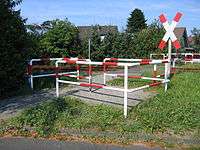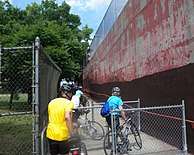Chicane
A chicane (/ʃɪˈkeɪn/) is a serpentine curve in a road, added by design rather than dictated by geography. Chicanes add extra turns and are used both in motor racing and on roads and streets to slow traffic for safety. For example, one form of chicane is a short, shallow S-shaped turn that requires the driver to turn slightly left and then slightly right to continue on the road, requiring the driver to reduce speed. The word chicane is derived from the French verb chicaner, which means "to create difficulties" or "to dispute pointlessly", "quibble".[1]
Motor racing

On modern racing circuits, chicanes are usually located after long straights, making them a prime location for overtaking. They can be placed tactically by circuit designers to prevent vehicles from reaching speeds deemed to be unsafe. A prime example of this is the three chicanes at the Autodromo Nazionale Monza, introduced in the early 1970s; the Chase at Mount Panorama, added in 1987; and the Tamburello chicane at Imola, which was placed in 1995 after Ayrton Senna's death at the original corner. At Le Mans, chicanes were placed alongside the 6‑km Mulsanne Straight in 1990 in order to slow down Le Mans Prototypes, which with Group C Prototypes went to speeds as high as 400 km/h.
Some tracks, such as the Yas Marina Circuit in Abu Dhabi, feature optional chicanes. Faster cars will take the chicane, but slower cars (such as amateur club racers) may avoid the chicane because they are not capable of reaching equally high speeds on the straights. Such chicanes are used at Watkins Glen International and Circuit de Barcelona-Catalunya, where there are separate chicanes for cars and motorcycles.
Another example is the Tsukuba Circuit in Japan. A chicane was added after Turn 7, creating a right turn, followed immediately by a left. This chicane is used only for motorcycles. It was implemented to divert motorcycles from taking Turn 8, which is a high speed long sweeping left corner. Turn 8 was deemed to be unsafe for motorcycles, as immediately following this is a slow right hairpin corner. This means riders may still have been leaning to the left when being expected to begin braking for Turns 9 and 10.
The term is used in other types of racing, such as bobsleigh, to indicate a similar shift in the course or track.
A slower driver or vehicle that delays competitors is sometimes disparaged as a mobile chicane or moving chicane. In some cases they may not move out of the way quickly enough to allow competitors in higher positions (having completed more laps) past, despite repeated showings of blue flags. This can cost competitors valuable time and championship points. This same term, applied to traffic calming, can refer to the usage of portable devices to create a chicane configuration.
Traffic calming

Chicanes are a type of "horizontal deflection" used in traffic calming schemes to reduce the speed of traffic. Drivers are expected to reduce speed to negotiate the lateral displacement in the vehicle path.[2] There are several variations of traffic calming chicanes, but they generally fall into one of two broad categories:
- Single-lane working chicanes, which consist of staggered buildouts, narrowing the road so that traffic in one direction has to give way to opposing traffic
- Two-way working chicanes, which use buildouts to provide deflection, but with lanes separated by road markings or a central island.
Limited accident data for chicane schemes indicate changes in injury accidents (range from −54% to +32%) and accident severity.[3][4]
Pedestrian
A pedestrian chicane is a kind of permanent fence used at a railway crossing to slow pedestrians down and to force them to observe both directions before crossing the railway tracks. While passing the chicane, one has to turn to the left and to the right, increasing the probability of seeing an approaching train. A similar arrangement is sometimes used at the entrances of parks to impede bicycle or car access.
 Chicane to prevent pedestrians from carelessly running across the track.
Chicane to prevent pedestrians from carelessly running across the track. Slowing bicycles
Slowing bicycles
See also
References
- "chi·cane verb \shi-ˈkān, chi-\". Le Parisien. Retrieved 10 August 2017.
- A Road Safety Good Practice Guide for Highway Authorities, First Edition, Appendix A.6, TRL Limited, Judith Barker and Chris Baguley, for the UK Department for Transport, March 2006 (Accessed 16 August 2011)
- UK Department for Transport Traffic Advisory Leaflet 12/97 Archived 2011-10-05 at the Wayback Machine, December 1997 (Accessed 16 August 2011)
- Urban Traffic Calming and Health, National Collaborating Centre for Healthy Public Policy, Canada